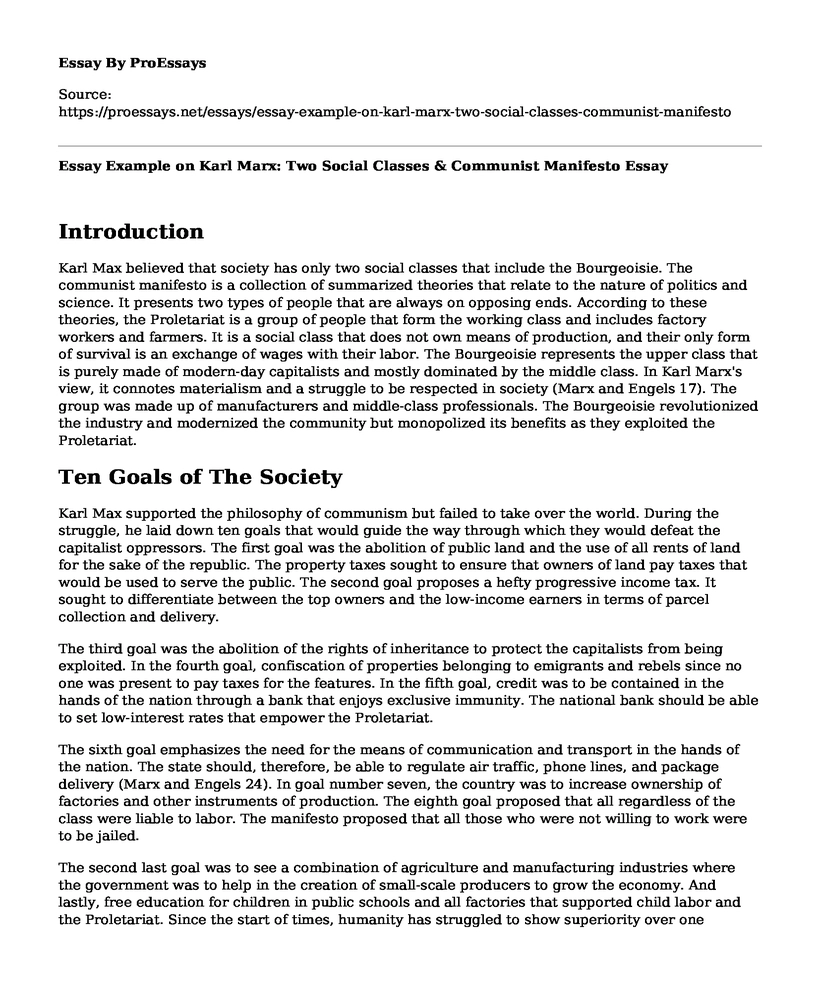Introduction
Karl Max believed that society has only two social classes that include the Bourgeoisie. The communist manifesto is a collection of summarized theories that relate to the nature of politics and science. It presents two types of people that are always on opposing ends. According to these theories, the Proletariat is a group of people that form the working class and includes factory workers and farmers. It is a social class that does not own means of production, and their only form of survival is an exchange of wages with their labor. The Bourgeoisie represents the upper class that is purely made of modern-day capitalists and mostly dominated by the middle class. In Karl Marx's view, it connotes materialism and a struggle to be respected in society (Marx and Engels 17). The group was made up of manufacturers and middle-class professionals. The Bourgeoisie revolutionized the industry and modernized the community but monopolized its benefits as they exploited the Proletariat.
Ten Goals of The Society
Karl Max supported the philosophy of communism but failed to take over the world. During the struggle, he laid down ten goals that would guide the way through which they would defeat the capitalist oppressors. The first goal was the abolition of public land and the use of all rents of land for the sake of the republic. The property taxes sought to ensure that owners of land pay taxes that would be used to serve the public. The second goal proposes a hefty progressive income tax. It sought to differentiate between the top owners and the low-income earners in terms of parcel collection and delivery.
The third goal was the abolition of the rights of inheritance to protect the capitalists from being exploited. In the fourth goal, confiscation of properties belonging to emigrants and rebels since no one was present to pay taxes for the features. In the fifth goal, credit was to be contained in the hands of the nation through a bank that enjoys exclusive immunity. The national bank should be able to set low-interest rates that empower the Proletariat.
The sixth goal emphasizes the need for the means of communication and transport in the hands of the nation. The state should, therefore, be able to regulate air traffic, phone lines, and package delivery (Marx and Engels 24). In goal number seven, the country was to increase ownership of factories and other instruments of production. The eighth goal proposed that all regardless of the class were liable to labor. The manifesto proposed that all those who were not willing to work were to be jailed.
The second last goal was to see a combination of agriculture and manufacturing industries where the government was to help in the creation of small-scale producers to grow the economy. And lastly, free education for children in public schools and all factories that supported child labor and the Proletariat. Since the start of times, humanity has struggled to show superiority over one another. Therefore, social class contributed to the creation of boundaries between the haves and have nots. And this is because; quality education, coupled with industrial production, would result in quality manpower for the progress of the economy.
The European economy had already adopted the modern bourgeois processes based on its transaction, exchange, property evaluation, and production. I agree with the ideas propounded by the manifesto because it will create a society where everyone has access to social amenities without decimation.
Work Cited
Marx, Karl, and Friedrich Engels. The Communist Manifesto. Waiheke Island: Floating Press, 1888.
Cite this page
Essay Example on Karl Marx: Two Social Classes & Communist Manifesto. (2023, May 21). Retrieved from https://proessays.net/essays/essay-example-on-karl-marx-two-social-classes-communist-manifesto
If you are the original author of this essay and no longer wish to have it published on the ProEssays website, please click below to request its removal:
- Gender Practices
- Presidential Power Essay
- Paper Example on Intelligence Community
- Auditing Robert's Dilemma Essay Example
- Research Paper on Abu Dhabi: Multi-Dimensional Environmental Challenges
- Essay Sample on Untrustworthy People: Manipulative, Exploitive and Dishonest
- First Nations' Right to Self-Governance in Canada - Essay Sample







